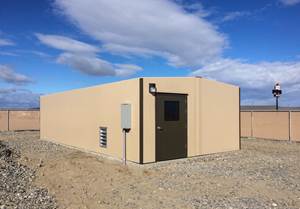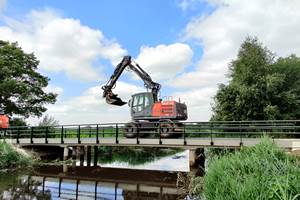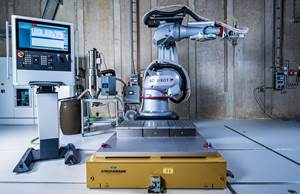Italian racer uses foam sandwich design, Scott Bader adhesive
Boatbuilder Anselmo Mauri has manufactured Revolver 42, a polyhedric monohull speedboat, constructed using high-permforance composites, including foam core sandwich design and adhesive provided by Scott Bader.
Revolver 42 is a polyhedric monohull speedboat, constructed using high performance composite materials by the Italian shipyard Anselmo Mauri (Sirmione, Lake Garda, Italy). Its design is a collaboration between the top U.S. speedboat hull designer Michael Peters Yacht Design, whose designs have won more than 200 Offshore Class 1 races worldwide, and the Milan-based studio H3O that carried out the interior design and all the concept engineering.
Innovations in the hull and deck design, such as centrally positioning the three structural tanks made of a special aeronautical rubber, in order to concentrate weight distribution in the middle of the boat, have been combined in the final design. The Revolver 42, with dimensions of 12.6m long by 3.4m wide and a dry weight of only 7,500 kg, has now become a reality, with its racing design pedigree enabling it to reach speeds of up to 68 knots.
With the hull design finalised, the H30 team worked closely with Resintex Technology Srl, the closed mold technology partner in the Revolver 42 project, to specify the best combination of high-performance composite materials available to design and manufacture a light and very fast speed boat, which would also be comfortable and maneuvrable at higher speeds, even in rough sea conditions. They opted for sandwich laminate structures for the main hull and deck, vacuum infused using Crystic vinyl ester (VE) resins and a Corecell M-foam core (from SP-High Modulus, Isle of Wight, U.K.), with carbon fiber used at major load points on the hard top. To further reduce weight, the hull bulkheads were bonded with a Crystic Crestomer structural adhesive provided by Scott Bader Company Ltd. (Wollaston, U.K.).
Resintex Technology’s technical consultant and project manager, Marco Arcuri, recommended vacuum bagging as the best infusion process to produce the hull and deck fibreglass sections as vacuum-infused laminates are significantly lighter compared to hand layup, while also providing better mechanical properties. To provide a tough, marine-approved laminate construction for the hull and deck, Scott Bader’s Crystic VE679-03PA infusion-grade, low-shrink dicyclopentadiene (DCPD)-modified VE resin was specified in combination with a "matched system" Crystic VE679PA skincoat. Scott Bader developed DCPD-modified VE resins and skin coats to provide the mechanical performance needed for marine applications, while also reducing print through to improve the aesthetic finish of the gelcoated surfaces of visible fibreglass parts; this is a key quality area for luxury power boats and yacht manufactures.
As well as having significantly lower resin material costs, compared with open mold hand layup, manufacturing by vacuum bagging infusion provides converters with the added production benefits of reducing overall labor costs, increasing productivity and significantly improving environmental and shop floor health and safety working conditions; styrene volatile organic compounds (VOC) emissions are typically reduced by more than 70 when using closed molding.
To help minimise the overall weight of Revolver 42, carbon fiber fabrics were used to reinforce the points of maximum loading in the cockpit hard top. Other critical performance areas subject to very high stresses and loads in the superstructure, such as the slamming area of the hull, were designed with a foam cored sandwich laminate structure. Marine-approved Corecell M-Foam DC core material was specified for the infused hull and deck sandwich constructions. Corecell M-Foam was specified because it provides a combination of high strength with a low density and very low resin absorption to significantly reduce laminate weight. For ease of molding, the double cut configuration of Corecell M-Foam provides flexibility in two directions in the mold; intersecting flow channels on both sides optimise resin flow and avoids an accumulation of resin in sections of the mold.
To make further reductions in the hull weight of Revolver 42, while at the same time improving the overall mechanical performance of the hull construction, Resintex Technology also recommended Scott Bader’s Crystic Crestomer 1152PA urethane acrylate structural adhesive to bond structural bulkheads in the hull. By using Crestomer 1152PA instead of over laminating, Revolver 42’s hull weight was reduced by more than 45 percent. Crystic Crestomer 1152PA has a much higher fatigue resistance, flexural modulus and ultimate tensile strength than the fibreglass laminate sections being bonded together, so failure is always in the substrate, with no adhesive or cohesive failure.
Related Content
Composite buildings go monocoque
Superior protection from the elements plus fast, affordable installation and maintenance have quickly made Orenco Composites’ DuraFiber buildings an attractive choice for water and wastewater, communications, transportation and power industry outbuildings.
Read MoreRefurbishing bridges at half the time, cost versus replacement
Instead of demolishing and rebuilding bridges, SUREbridge doubles the strength and durability of existing structures with an FRP deck for a smart, sustainable solution.
Read MoreDemonstrating functionalized, cost-effective composites using additive extrusion
Hybrid thermoset/thermoplastic composite part with 3D-printed functionalization demonstrates technology possibilities and EmpowerAX open platform offering expertise from members throughout the process chain.
Read MoreDigitizing tools for composites production
Alpex Technologies focuses on industrialization, process and part intelligence and biocomposites in its next generation of tooling systems.
Read MoreRead Next
CW’s 2024 Top Shops survey offers new approach to benchmarking
Respondents that complete the survey by April 30, 2024, have the chance to be recognized as an honoree.
Read MoreComposites end markets: Energy (2024)
Composites are used widely in oil/gas, wind and other renewable energy applications. Despite market challenges, growth potential and innovation for composites continue.
Read MoreFrom the CW Archives: The tale of the thermoplastic cryotank
In 2006, guest columnist Bob Hartunian related the story of his efforts two decades prior, while at McDonnell Douglas, to develop a thermoplastic composite crytank for hydrogen storage. He learned a lot of lessons.
Read More
















.jpg;maxWidth=300;quality=90)








